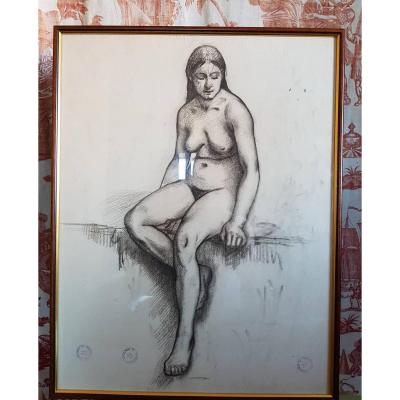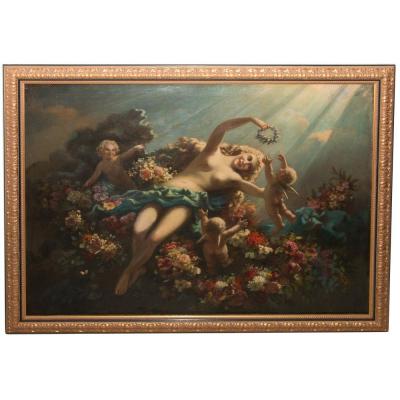In 1848, Charles-François received a second-class medal for one of his paintings exhibited at the Salon, while first-class medals went to Corot and Delacroix.
He then received his first state commission for an etching. A few years later, in 1852, as he gained more recognition at the Salon, the state purchased two of his paintings. One of them, "La Moisson," is now housed in the Musée d'Orsay.
Charles-François Daubigny fortuitously met Corot, whom he had only known through his works, and they connected immediately, despite Corot being nearly twenty years older.
In 1853, Charles-François and Marie-Sophie welcomed their third child, Bernard.
Awarded numerous prizes and medals, Charles-François's work became increasingly appreciated, though it faced criticism from some who found it too loose in execution.
**The Bateau-Atelier**
In 1857, to be closer to the motifs and water he loved to depict, Daubigny purchased a boat that had once served as a ferry: the "Botin." He had a cabin built on it for shelter and sleeping, which became his Bateau-Atelier.
Every summer, he traveled to Auvers-sur-Oise, a peaceful place not far from Valmondois, where he spent part of his childhood. He made the Île de Vaux his main base, navigating the waterways and even reaching Honfleur, accompanied by Karl, “the cabin boy.” After several stays along the Côte Fleurie in Normandy, he decided to return to Auvers-sur-Oise to settle there.
His fame grew, and in 1860, Napoleon III purchased his painting "Etang de Gylieu," recognized as a masterpiece.
*Years later, in 1873, Monet would adopt the idea of a studio boat from Daubigny, having one built for himself as well.*
**The First Artistic Hub in Auvers-sur-Oise**
In 1860, Daubigny bought land in Auvers to establish his "country studio." He increasingly focused on the play of light.
In 1861, the first artistic hub of Auvers-sur-Oise emerged. Daubigny’s Maison-Atelier quickly became a place for meetings and collaboration, where he had many students.
His close friends (Oudinot, Corot, Daumier, Geoffroy Dechaume, etc.) convinced him to decorate this magical place, and Corot, as the designer, painted Italian landscapes he adored.
Over time, the "Botin" began to deteriorate, eventually ending its days in the garden of the Maison-Atelier as a bar and shelter. It was replaced by the "Bottin," a larger, better-equipped boat for navigation, operational by 1868. At that time, Bernard became the cabin boy, and Karl was promoted to captain!
*The models of both boats were crafted by Charles-François's descendant, Daniel Raskin, and are occasionally exhibited at the Maison-Atelier de Daubigny.*
**The Advocate of Nouveau Art and a Loyal Friend**
Starting in 1866, Charles-François Daubigny supported the new school artists, such as Cézanne and Renoir, alongside his friend Corot. However, he could not get them admitted to the Salon. That same year, he traveled to England and exhibited two paintings at the Royal Academy.
In 1868, Daubigny succeeded in promoting Monet, Pissarro, Renoir, Degas, Sisley, and Berthe Morisot, provoking the ire of the superintendent of fine arts. When Monet and Sisley were rejected from the Salons of 1869 and 1870, Daubigny, along with Corot, resigned from the jury.
Daubigny fled to England in 1870 during the war, where the news was grim; the French artists seeking refuge in London were in distress. By chance, Daubigny encountered Monet and helped him, and soon Pissarro found solace as well, with art dealer Durand-Ruel selling some of his works.
After the 1870 war, the Daubigny family returned to France, staying in various towns before settling in Paris. The Salon, which had been suspended during the war, resumed, and Charles-François exhibited two paintings that sold.
Following a trip to Holland in 1871, he welcomed Monet and Pissarro into his home in Auvers-sur-Oise, as well as other young talents, such as Cézanne, who arrived in Auvers in 1872.
**His Later Years**
At the 1873 Salon, Daubigny won a grand prize for his painting "La Neige," now in the Musée d'Orsay, despite harsh criticism. These critiques echoed those later directed at the Impressionists. Today, Daubigny is considered a major precursor of the Impressionist movement.
“...I will mention another painting by Daubigny, 'La Neige,' which was at the 1872 exhibition. Nothing more simple yet expansive can be imagined. The fields are white with snow; a path crosses them, bordered on both sides by gnarled apple trees. And on this white blanket, across the fields and trees, a massive flock of crows has descended, dark, motionless, swirling. The entirety of winter is laid out before us. In my life, I have seen nothing more melancholic; Daubigny’s brush, delicate rather than forceful, has acquired exceptional strength to render the bleak view of our plains in December.” — Émile Zola
**His Passing**
As the years went by, Daubigny faced health issues but continued his outings aboard the "Bottin." Returning to Auvers-sur-Oise, he purchased another house near the train station, though he never lived there.
Growing increasingly tired, he undertook a final cruise with his two sons toward Rouen. He returned to his friends in Auvers, and as winter approached, he worked in his Paris studio.
Stricken by a cardiac episode, he passed away on February 19, 1878.
Buried in the Père Lachaise cemetery in Paris, he rests beside his lifelong friend Corot. A bust sculpted in marble by Geoffroy-Dechaume adorns his grave, and Daumier lies not far away. They had expressed the desire to be buried close to each other to continue their laughter together...
"My uncle told me that Daubigny has died. I confess it pains me... It must be a good thing to have the awareness in dying that one has done truly good things, to know that, thanks to that, one will remain alive in the memory of at least a few, and to leave a good example for those who follow." — Vincent Van Gogh, letter to Theo, 1878.
Daubigny's Tomb, next to Corot. Père Lachaise Cemetery - Paris - France.




























 Le Magazine de PROANTIC
Le Magazine de PROANTIC TRÉSORS Magazine
TRÉSORS Magazine Rivista Artiquariato
Rivista Artiquariato